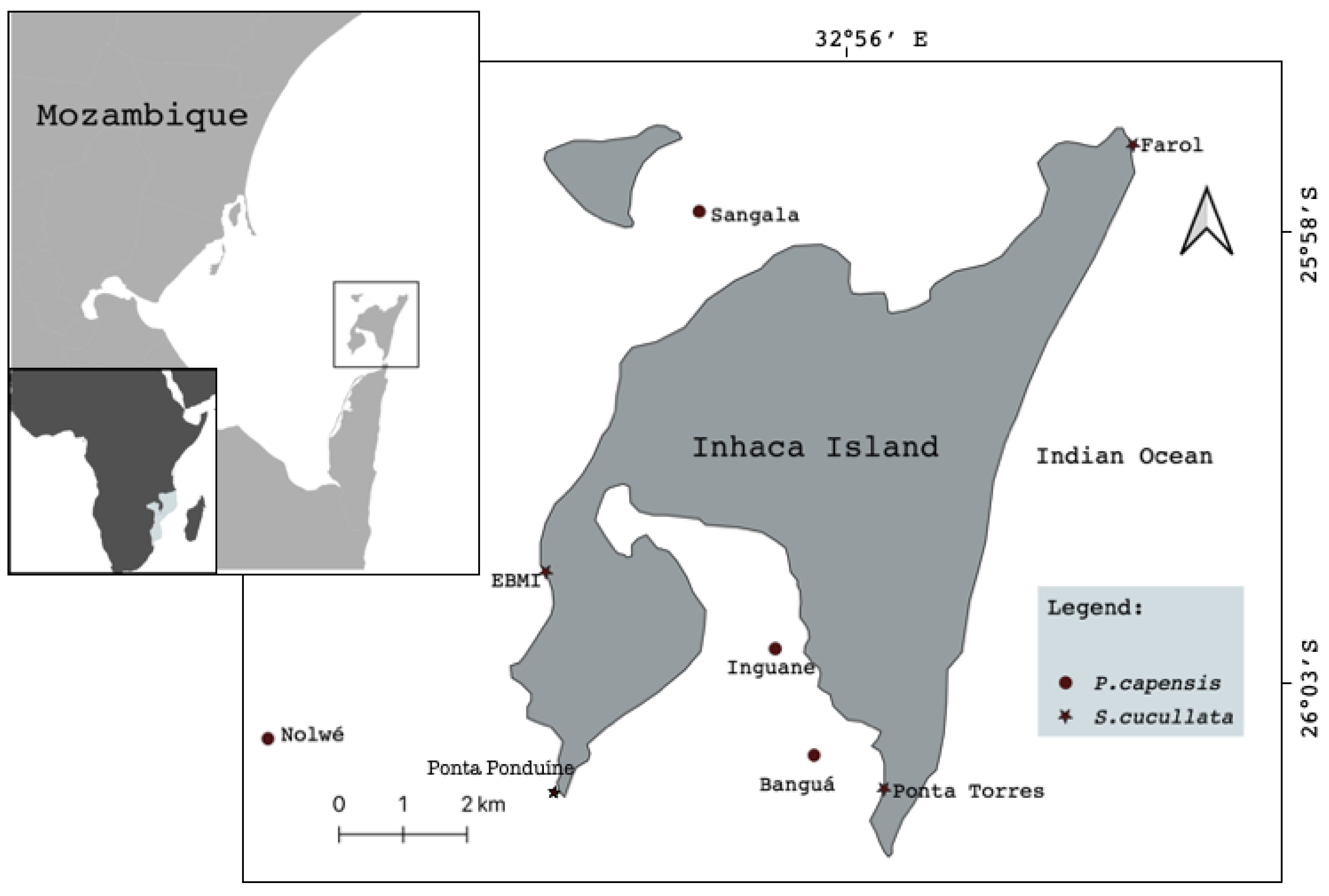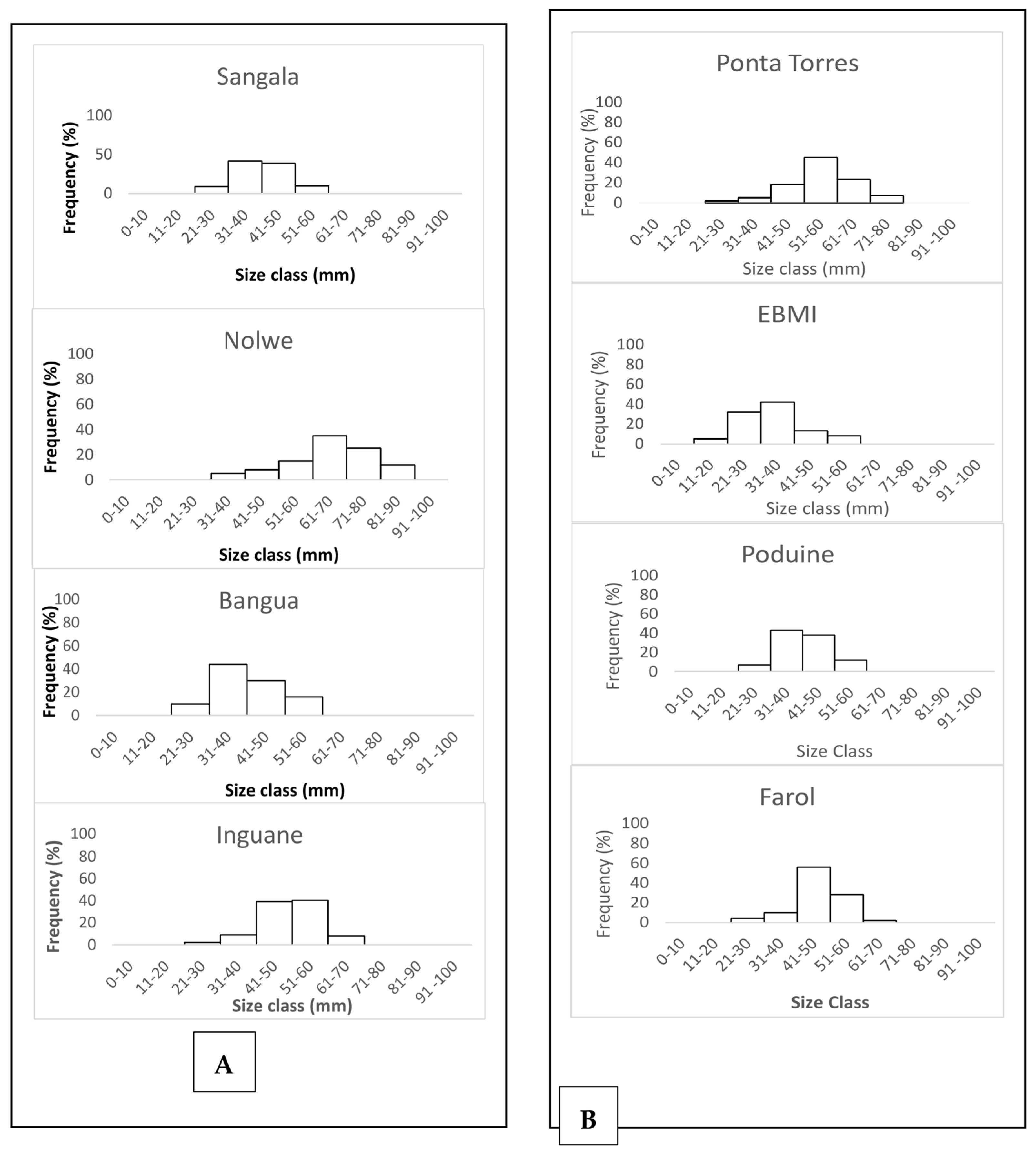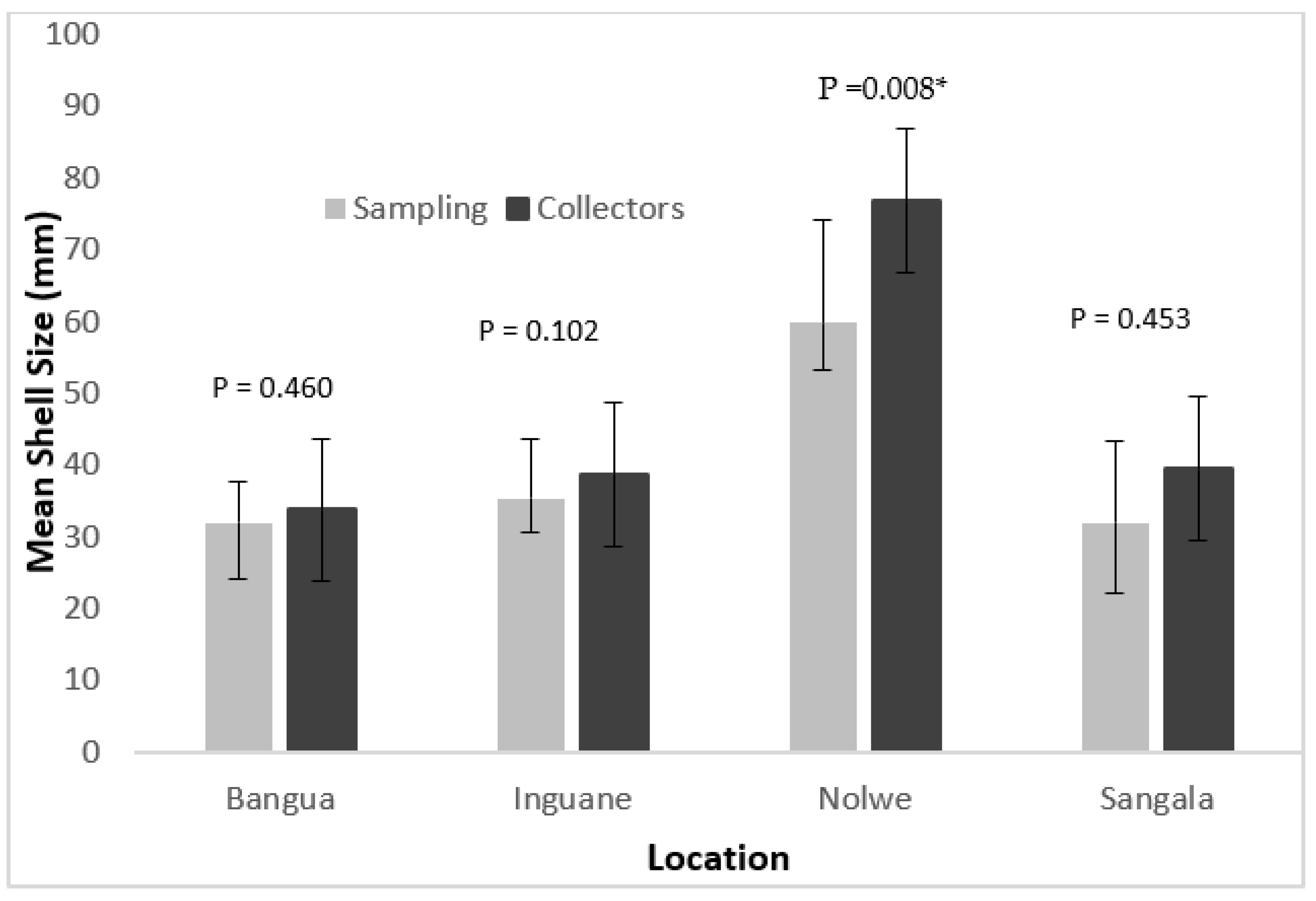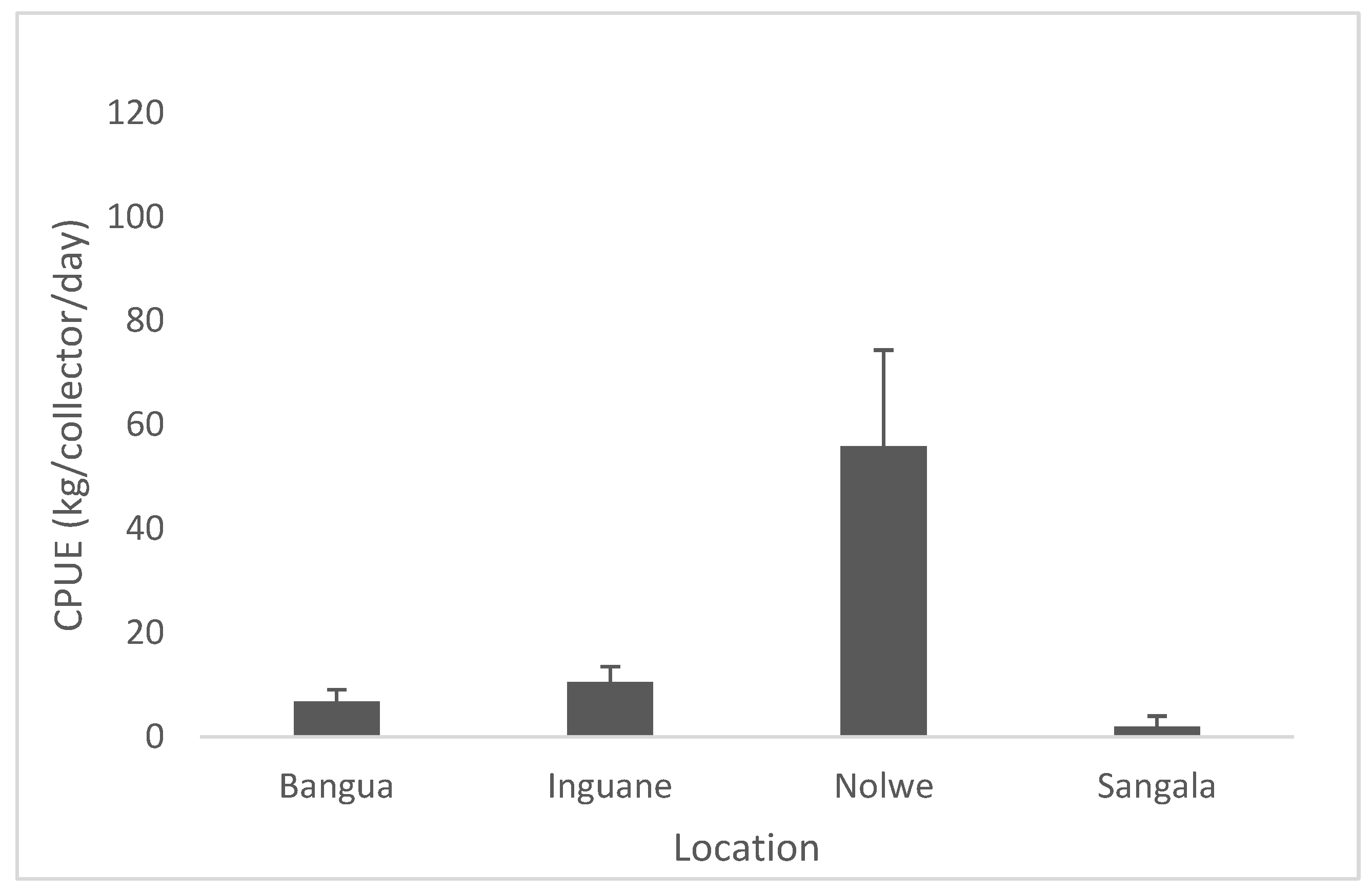Catch per Unit Effort, Density and Size Distribution of the Oysters Pinctada capensis and Saccostrea cucullata (Class Bivalvea) on Inhaca Island, Southern Mozambique
Abstract
1. Introduction
2. Materials and Methods
2.1. Study Area
2.2. Data Collection
2.3. Data Analysis
3. Results
3.1. Interviews
3.2. Field Sampling
4. Discussion
Author Contributions
Funding
Institutional Review Board Statement
Informed Consent Statement
Data Availability Statement
Conflicts of Interest
References
- Quan, W.; Fan, R.; Wang, Y.; Humphries, A.T. Long-Term Oyster Recruitment and Growth are not Influenced by Substrate Type in China: Implications for Sustainable Oyster Reef Restoration. J. Shellfish Res. 2017, 36, 79–86. [Google Scholar] [CrossRef]
- Guo, X.; Li, C.; Wang, H.; Xu, Z. Diversity and Evolution of Living Oysters. J. Shellfish Res. 2018, 37, 755–771. [Google Scholar] [CrossRef]
- Angel, C.L. The Biology and Culture of Tropical Oysters; ICLARM Studies and Reviews: Manila, Philippines, 1986; 42p. [Google Scholar]
- Akele, G.D.; Montcho, S.A.; Chikou, A.; Mensah, G.A.; Laleye, P.A. Traditional exploitation of edible freshwater oyster Etheria elliptica (Lamarck, 1807) in Pendjari River (Benin-West Africa): Assessment of income, human pressure and options for management. Int. J. Biol. Chem. Sci. 2015, 9, 246–258. [Google Scholar] [CrossRef]
- DNAC. Plano de Maneio da Reserva Marinha Parcial da Ponta do Ouro, 1st ed.; Ministerio do Ambiente: Maputo, Mozambique, 2011; 66p. [Google Scholar]
- FAO. The State of World Fisheries and Aquaculture 2018—Meeting the Sustainable Development Goals; FAO: Rome, Italy, 2018. [Google Scholar]
- Beck, M.W.; Brumbaugh, R.D.; Airoldi, L.; Carranza, A.; Coen, L.D.; Crawford, C.; Defeo, O.; Edgar, G.J.; Hancock, B.; Kay, M.C.; et al. Oyster reefs at risk and recommendations for conservation, restoration, and management. Bioscience 2011, 61, 107–116. [Google Scholar] [CrossRef]
- Hoguane, A.M. Perfil Diagnóstico da Zona Costeira de Moçambique. Rev. Gestão Costeira Integr. 2008, 7, 69–82. [Google Scholar] [CrossRef]
- Barnes, D.K.A.; Corrie, A.; Whttington, M.; Carvalho, M.A.; Gell, F. Coastal shellfish resource use in the Quirimba Archipelago, Mozambique. J. Shellfish Res. 1998, 17, 51–58. [Google Scholar]
- Pereira, I.J.F.; do Nascimento, F.R. Avaliação dos Recursos Naturais na Ilha Da Inhaca (Oceano Índico, Moçambique): Primeira Aproximação. Bol. Goiano Geogr. 2016, 36, 307–325. [Google Scholar]
- Scarlet, M.P.J. Clams as a resource in Maputo Bay—Mozambique. Master’s Thesis, Department of Marine Ecology, Göteborg University Sweden, Gothenburg, Sweden, 2013; 23p. [Google Scholar]
- De Boer, W.F.; Prins, H.H.T. The community structure of a tropical intertidal mudflat under human exploitation. ICES J. Mar. Sci. 2001, 59, 1237–1247. [Google Scholar] [CrossRef]
- De Boer, W.F.; Pereira, T.; Guissamulo, A. Comparing recent and abandoned shell middens to detect the impact of human exploitation on the intertidal ecosystem. Aquat. Ecol. 2000, 34, 287–297. [Google Scholar] [CrossRef]
- Hwang, J.J.; Yamakawa, T.; Aoki, I. Growth of wild pearl oysters Pinctada fucata, Pinctada margaritifera and Pinctada sugillata (Bivalvia: Pteriidae) in Taiwan. Fish. Sci. 2007, 73, 132–141. [Google Scholar] [CrossRef]
- Mcdonald, S.; Essington, T.E.; Davis, J.P.; Galloway, A.W.E.; Stevick, B.C.; Jensen, G.C.; Vanblaricom, G.R.; Armstrong, D.A. Distribution, Abundance, and Habitat Associations of a Large Bivalve (Panopea generosa) in a Eutrophic Fjord Estuary. J. Shellfish Res. 2015, 34, 137–145. [Google Scholar] [CrossRef]
- Kalk, M. A Natural History of Inhaca Island, Mozambique, 3rd ed.; Witwatersrand University Press: Johannesburg, South Africa, 1995. [Google Scholar]
- Emanuelsson, A.; Isaksson, D. Inhaca Marine Biology Research Station Mozambique, Sweden. 2016. Available online: www.globalreporting.net (accessed on 4 December 2022).
- Zar, J.H. Biostatistical Analysis, 5th ed.; Prentice Hall: Upper Saddle River, NJ, USA, 2010; p. 947. [Google Scholar]
- Nrepo, M.A.A. Distribuição, Abundância e Avaliação da Exploração Humana da Ostra de Areia (Pinctada imbricata) na Costa dos Distritos de Inhassoro e Vilanculos, Inhambane. Bachelor’s Thesis, Departamento de Ciências Biologicas, Faculdade de Ciências, Universidade Eduardo Mondlane, Maputo, Mozambique, 2011; p. 37. [Google Scholar]
- Videira, E.J.S. A Exploração, Crescimento e Ciclo Reprodutivo da Ostra Perlífera Akoya (Bivalvia: Pteriidae) num Banco de Ervas Marinhas, Ilha de Bazaruto, Moçambique. Master’s Thesis, Universidade Eduardo Mondlane, Maputo, Mozambique, 2011; p. 67. [Google Scholar]
- Al-Khayat, J.A.; Al-Ansi, M.A. Ecological features of oyster beds distribution in Qatari Waters, Arabian Gulf. Asian J. Sci. Res. 2008, 1, 544–561. [Google Scholar] [CrossRef]
- Yassien, M.H.; El-Ganainy, A.A.; Hasan, M.H. Shellfish fishery in the North Western part of the Red Sea. World J. Fish Mar. Sci. 2009, 1, 97–104. [Google Scholar]
- Mackenzie, C.L., Jr.; Troccoli, L.; León, L.B. History of the Atlantic pearl oyster, Pinctada imbricata, industry in Venezuela and Colombia, with biological and ecological observations. Mar. Fish. Rev. 2003, 65, 1–20. [Google Scholar]
- Armstrong, C.W.; Falk-Petersen, J. Food for Thought—Habitat-fisheries Interactions: A Missing Link? ICES J. Mar. Sci. 2008, 65, 817–821. [Google Scholar] [CrossRef]
- Christo, S.W. Biologia Reprodutiva e Ecologia de Ostras do Gênero Crassostrea (Sacco, 1897) na Baía de Guaratuba (Paraná–Brasil): Um Subsídio ao Cultivo. Ph.D. Thesis, Tese Doutorado Em Ciências Biológicas- Zoologia, Universidade Federal do Paraná, Curitiba, Brazil, 2006; p. 146. [Google Scholar]
- Frederick, P.; Vitale, N.; Pine, B.; Seavey, J.; Sturmer, L. Reversing a rapid decline in oyster reefs: Effects of durable substrate on oyster populations, elevations, and aquatic bird community composition. J. Shellfish Res. 2016, 35, 359–367. [Google Scholar] [CrossRef]
- Filipe, O.J. Estado actual da ostra de areia Pinctada imbricata, na zona norte da Ilha do Bazaruto. Bachelor’s Thesis, Departamento de Ciências Biologicas, Faculdade de Ciências, Universidade Eduardo Mondlane, Maputo, Mozambique, 2006; 28p. (In Portuguese). [Google Scholar]
- De Boer, W.F.; Blijdenstein, A.F.; Longamane, L. Prey Choice and Habitat use of People Exploiting Intertidal Resources. Environ. Conserv. 2002, 29, 238–252. [Google Scholar] [CrossRef][Green Version]
- Haupt, T.M.; Griffiths, C.L.; Robinson, T.B.; Tonin, A.F.G.; de Bruyn, P.A. The History and status of oyster exploitation and culture in South Africa. J. Shellfish Res. 2010, 29, 151–159. [Google Scholar] [CrossRef]
- Rius, M.; Kaehler, S.; McQuaid, C.D. The relationship between human exploitation pressure and condition of mussel populations along the south coast of South Africa. S. Afr. J. Sci. 2006, 102, 130–136. [Google Scholar]
- Tranter, D.J. Reproduction in Australian Pearl oyster (Lamellibranchia). I. Pinctada albina (Lamarck): Primary Gonad Development. Aust. J. Mar. Freshw. Res. 1958, 9, 135–146. [Google Scholar] [CrossRef]
- Rao, G.S. Growth and biometric relationship of the Indian pearl oyster Pinctada fucata (Gould) under long term onshore rearing system. J. Mar. Biol. Assoc. 2007, 49, 51–57. [Google Scholar]
- Tenjing, S.Y. Population dynamics of the edible rock oyster Saccostrea cucullate (Born, 1778) along the south-west coast of India. Indian J. Fish. 2020, 67, 12–22. [Google Scholar] [CrossRef]
- Gervis, M.H.; Sims, N.A. The Biology and Culture of Pearl Oysters (Bivalvia: Pteriidae); ODA/ICLARM: Manila, Philippines, 1992. [Google Scholar]
- Gu, Z.; Wang, Q.; Fang, J.; Ye, N.; Mao, Y.; Shi, Y.; Wang, Y.; Wang, A. Growth of cultured pearl oyster (Pinctada martensii) in Li’an Lagoon, Hainan Island, China. J. Shellfish Res. 2009, 28, 465–470. [Google Scholar]
- Hartill, B.W.; Cryer, M.; Morrison, M.A. Estimates of biomass, sustainable yield, and harvest: Neither necessary nor sufficient for the management of non-commercial urban intertidal shellfish fisheries. Fish. Res. 2005, 71, 209–222. [Google Scholar] [CrossRef]
- Strayer, D.L. Challenges for freshwater invertebrate conservation. J. N. Am. Benthol. Soc. 2006, 25, 271–287. [Google Scholar] [CrossRef]
- Carranza, A.; Defeo, O.; Beck, M. Diversity, conservation status and threats to native oysters (Ostreidae) around the Atlantic and Caribbean coasts of South America. Aquat. Conserv. Mar. Freshw. Ecosyst. 2009, 19, 344–353. [Google Scholar] [CrossRef]
- FAO. Aquaculture Development-Use of Wild Fishery Resources for Capture-Based Aquaculture; FAO: Rome, Italy, 2011; 81p. [Google Scholar]
- Tamburri, M.N.; Luckenbach, M.W.; Breitburg, D.; Bonniwell, S. Settlement of Crassostrea ariakensis larvae: Effects of substrate, biofilms, sediment and adult chemical cues. J. Shellfish Res. 2008, 27, 601–608. [Google Scholar] [CrossRef]





| Pinctada capensis | Saccostrea cucullata | ||
|---|---|---|---|
| Site | Density (ind/m2) | Site | Density (ind/m2) |
| Bangua | 11 ± 2.8 a | EBMI | 61 ± 7 a |
| Inguane | 14 ± 6 a | Farol | 50 ± 5 b |
| Nolwe | 11 ± 3.5 a | Ponta Ponduine | 35 ± 4 c |
| Sangala | 4 ± 3 b | Ponta Torres | 51 ± 8 b |
| Site | Mean ± SE (mm) | Minimum (mm) | Maximum (mm) |
|---|---|---|---|
| Bangua (n = 364) | 31.9 ± 9.9 a | 21.5 | 56.6 |
| Inguane (n = 466) | 35.3 ± 8.3 a | 19 | 70.2 |
| Nolwe (n = 360) | 59.8 ± 18.6 b | 24.9 | 88.8 |
| Sangala (n = 176) | 32 ± 17.8 a | 20.7 | 60 |
| Site | Mean ± SE (mm) | Minimum (mm) | Maximum (mm) |
|---|---|---|---|
| EBMI (n = 105) | 30.1 ± 6.2 a | 13 | 51.3 |
| Farol (n = 245) | 30.6 ± 7 a | 21.6 | 63 |
| Ponta Punduine (n = 102) | 33.2 ± 6.9 a | 22.9 | 55.4 |
| Ponta Torres (n = 106) | 42.9 ± 8.8 b | 24 | 79.4 |
Disclaimer/Publisher’s Note: The statements, opinions and data contained in all publications are solely those of the individual author(s) and contributor(s) and not of MDPI and/or the editor(s). MDPI and/or the editor(s) disclaim responsibility for any injury to people or property resulting from any ideas, methods, instructions or products referred to in the content. |
© 2022 by the authors. Licensee MDPI, Basel, Switzerland. This article is an open access article distributed under the terms and conditions of the Creative Commons Attribution (CC BY) license (https://creativecommons.org/licenses/by/4.0/).
Share and Cite
Mafambissa, M.J.; Gimo, C.A.; Andrade, C.P.; Macia, A.A. Catch per Unit Effort, Density and Size Distribution of the Oysters Pinctada capensis and Saccostrea cucullata (Class Bivalvea) on Inhaca Island, Southern Mozambique. Life 2023, 13, 83. https://doi.org/10.3390/life13010083
Mafambissa MJ, Gimo CA, Andrade CP, Macia AA. Catch per Unit Effort, Density and Size Distribution of the Oysters Pinctada capensis and Saccostrea cucullata (Class Bivalvea) on Inhaca Island, Southern Mozambique. Life. 2023; 13(1):83. https://doi.org/10.3390/life13010083
Chicago/Turabian StyleMafambissa, Mizeque Julio, Celia Angelica Gimo, Carlos Pestana Andrade, and Adriano Afonso Macia. 2023. "Catch per Unit Effort, Density and Size Distribution of the Oysters Pinctada capensis and Saccostrea cucullata (Class Bivalvea) on Inhaca Island, Southern Mozambique" Life 13, no. 1: 83. https://doi.org/10.3390/life13010083
APA StyleMafambissa, M. J., Gimo, C. A., Andrade, C. P., & Macia, A. A. (2023). Catch per Unit Effort, Density and Size Distribution of the Oysters Pinctada capensis and Saccostrea cucullata (Class Bivalvea) on Inhaca Island, Southern Mozambique. Life, 13(1), 83. https://doi.org/10.3390/life13010083







